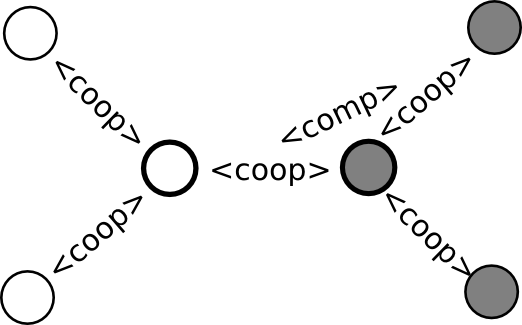Decety et al. wrote a very intersting article, comparing cooperation and competition using brain scans.
Cooperation and competition are two basic modes of social cognition that necessitate monitoring of both one’s own and others’ actions, as well as adopting a specific mental set.
They demonstrate that for both modes two identical parts are active: (1) a network serving executive functions which enables flexible behavior and (2) a part involved in the sense of agency, that is ‘the feeling that we are the cause of our actions and their consequences’. This latter part:
is shown to play a role in the integration of emotion and behavior.
Both parts play a crucial role during social relations:
… both cooperation and competition involve anticipating the behavior of one’s social partner, which relies heavily on ‘‘mentalizing,’’
Moreover,
… distinct regions were found to be selectively associated with cooperation and competition…
They argue -within a context of 1 self and 1 other- that cooperation is a more socially rewarding process, backed by ample evidence from evolutionary and developmental psychology (no sources, but we get the point). Another difference is the suggestion that self-other merging is greater in cooperation conditions.
Further on Decety et al. state that:
Adopting a competitive stance requires a {stronger} mentalizing component to maintain both self and other perspectives of the game and therefore, we hypothesize, requires the computing resources of the medial prefrontal cortex.
What does this research mean to group behavior? It helps us to define group behavior.
First of all, without individual motivation, intention and behavior nor group competition nor group cooperation will exist. Or won’t it? Take some grass on a sand dune. They will ‘compete’ for space and water (with each other and other species), and they will ‘cooperate’ making the dune resistant to wind. They have not really a motivation, intention or individual behavior, although the physical nature of the tussocks of grass seems to imply ‘human’ charcteristics. We seem to descibe group behavior with the same attributes as we use to describe individual behavior. Not sure yet how to deal with this. Let’s park it for now.
Second, let’s look closer at the ‘sense of agency’. When I type these words using my fingers, knowing I move them is an example of sense of agency (SA). Knowing these are indeed my fingers, is a sense of ownership (SO). Normally these senses are intertwined. Schizoprenic people have no integrated SA & SO:
… the schizophrenic patient has a sense of ownership, but not a sense of agency (source)
Knowing this and reading back on this previous post, we could hypothesize that all group cooperations are -in a way- schizophrenic.
Third, taking the social reward of cooperation into account, what does that mean to the concept of differentiation on time, place and decision making unit? In other words, what does it mean to loyalty within and between groups.

Apparently different cooperative relations at the same time result in competition between those cooperative relations. We can say there is lively rivalry between social rewards. Time for a break to try and become truely aware of this other level.